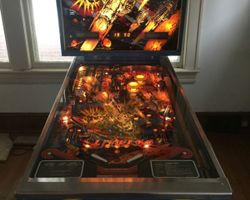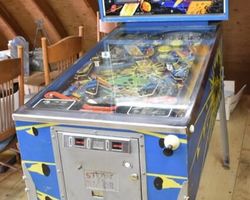Flight 2000

Average Prices: USD $300 to $1,300
Produced: August, 1980
Production Run: 6,301 units
Machine Type: Solid State Electronic
MPU: Stern M-200 MPU
Players: 4
Design by: Harry Williams
Art by: Doug Watson, Gerry Simkus
Software by: Bill Pfutzenreuter
The September 1980 release of Flight 2000 by Stern Electronics, Incorporated marked a significant point in the evolution of solid-state pinball machines. Designed by Harry Williams, with artwork contributed by Doug Watson and Gerry Simkus, and software by Bill Pfutzenreuter, this wide body machine was Stern’s inaugural entry into the realm of pinball with integrated speech. The production run, totaling 6,301 units, unfolded between August 15 and December 12, 1980, making it a notable success for the manufacturer. Its theme, deeply rooted in science fiction and outer space exploration, resonated with players drawn to the cosmos. The development team aimed to create an immersive experience, leveraging new technology to enhance the traditional pinball format. The inclusion of custom speech, powered by Stern’s VSU-100 speech board, was a bold step, setting Flight 2000 apart from its contemporaries and establishing a new benchmark for Stern's future designs. A unique tidbit from its development involves the machine's lack of a traditional knocker for free game awards; every solenoid driver on the board was utilized for gameplay features, leaving no capacity for this common element.
Signature Features and Design
Flight 2000 distinguishes itself through several pioneering elements, most notably its innovative three-ball multiball mechanism, often referred to as the "ball walker" or "Apollo launch section." Situated in the upper left of the playfield, this intricate, maze-like arrangement stages the machine's signature "lift-off" sequence. Balls are carefully locked and then delivered by a captive ball walker to kickers, which propel them sequentially to the top arch, culminating in the initiation of multiball. This elaborate mechanical ballet was a visual and auditory spectacle, designed to elevate the player’s experience beyond simple ball locks.
Beyond its mechanical innovation, Flight 2000 introduced custom speech to the Stern lineup. The robotic voice, delivered through the VSU-100 speech board, served to announce game states, guide players, and punctuate the "BLASTOFF" multiball sequence with thematic vocalizations. This auditory feedback deepened player immersion and became a hallmark of the machine. As a wide body design, Flight 2000 offered an expansive playfield canvas. Its aesthetic was defined by a compelling space theme, rendered through a palette of blues, blacks, and cosmic imagery that adorned both the playfield and the backglass. The machine also featured a 7-digit plasma display for scores, complemented by a separate 6-digit display dedicated to status updates, a thoughtful design choice that provided players with clear, immediate information without cluttering the main score readouts.
Playfield and Mechanics
The playfield of Flight 2000 is laid out to encourage a variety of shots and strategic progression, leveraging its wide body form factor. At the heart of the upper left quadrant lies the elaborate "Apollo launch section," home to the captive ball walker and the intricate ball lock mechanism for multiball. This section isn't merely decorative; it's a dynamic staging area where balls are cycled and launched with precision, creating a tangible sense of a space mission countdown.
Central to the lower playfield are the two main flippers, flanked by four active slingshots. These slingshots, strategically placed, ensure that the ball remains highly active, contributing to the game's surprisingly fast pace for a wide body machine. Two pop bumpers add to the chaotic energy, driving the ball unpredictably into various targets. The playfield also features multiple drop target banks crucial for scoring and advancing game objectives. A prominent set of five memory drop targets is positioned to initiate a "countdown" sequence, typically 5-4-3-2-1, building tension and anticipation. Additionally, a three-bank drop target assembly allows for sweeping shots and accumulates points.
Other interactive elements include three standup targets, two spinning targets that yield significant points when hit repeatedly, two kickers, and dual inlanes on each side for skill shots and ball control. A narrow slotted stand-up target offers high point values, instantly adds to the bonus multiplier, spots a letter towards "BLAST," and can light the special award. Artwork across the playfield is meticulously integrated, depicting starships, planets, and nebulae, all bathed in cool blues and deep blacks. The lighting scheme complements this theme, using selective illumination to guide players to critical shots and highlight achievements. The overall design philosophy emphasizes a clear, linear progression toward multiball, with visual and auditory cues consistently reinforcing the space exploration narrative.
Gameplay Dynamics
Gameplay in Flight 2000 centers on a direct and engaging objective: initiating the three-ball multiball sequence by spelling "BLASTOFF." This primary goal is achieved by hitting a series of targets and navigating specific playfield features. The five memory drop targets are integral to this process, requiring players to hit them sequentially to complete a descending countdown. Each successful hit advances the player closer to unlocking the critical "BLASTOFF" letters.
The three-ball multiball is the game's highlight, initiated through the unique "Apollo launch section." Once unlocked, balls are staged and then simultaneously launched from separate "lift-off" stages, creating a moment of high energy and scoring potential. During multiball, players aim to keep multiple balls in play, hitting targets for maximized scoring and attempting to cycle balls through the playfield to maintain momentum. The two spinning targets are particularly valuable, offering escalating points with continuous hits, and their values can even carry over between games, rewarding skilled players.
The scoring system encourages a blend of precision and rapid-fire play. Beyond the primary objectives, players can accumulate points by hitting standup targets, drop target banks, and keeping the ball active within the pop bumper area. The bonus multiplier, which can be increased by hitting the narrow slotted stand-up target, adds a strategic layer to end-of-ball scoring, encouraging players to build up their bonus throughout the game. The custom speech, "Stern's first talking Pinball Game is Really Taking Off!", serves not only as thematic flavor but also as functional feedback, announcing game states and celebrating milestones like a successful "BLASTOFF." The game’s clear ruleset and distinct objectives make it accessible for new players while offering enough challenge and strategic depth to keep experienced pinball enthusiasts engaged in repeated attempts to master the "lift-off" sequence.
Reception and Legacy
Flight 2000 received a largely positive reception within the pinball community, cementing its place as a memorable title from Stern Electronics' early solid-state era. Its average rating among enthusiasts hovers around 8.16, indicating a generally favorable view. One of the most frequently lauded aspects is its singular multiball feature. The "ball walker" mechanism and the accompanying "blastoff" sequence were considered innovative and captivating for their time, providing a distinct reward for achieving the primary objective. Players often highlighted the satisfaction derived from successfully initiating this sequence, praising its unique execution and the accompanying sound effects.
Many players appreciated the challenging nature of Flight 2000. While some found the multiball difficult to achieve, this difficulty was often seen as a strength, contributing to the machine’s replayability and encouraging continued engagement. The speed of play, despite being a wide body design, was another point of praise, with the four slingshots contributing to a surprisingly kinetic experience. The game’s space theme and accompanying artwork, particularly the playfield’s distinctive blues and blacks, were also well-received, often cited as fitting for the era and visually appealing. As Stern’s first game to incorporate speech, Flight 2000 was recognized for its technological advancement, with the robotic voice being seen as a fitting thematic element.
However, Flight 2000 was not without its criticisms. A common point of contention was the physical space occupied by the ball walker mechanism. Some players felt it made the upper left playfield feel constrained or that it functioned more as an "eye candy" feature rather than a core gameplay driver, limiting other potential playfield elements. A minority of players found the game's ruleset somewhat linear, leading to a sense of repetitiveness over extended play sessions once the primary objective of spelling "BLASTOFF" became routine. The difficulty of achieving multiball, while a positive for many, was a source of frustration for some, detracting from their overall enjoyment. Furthermore, a minor inconvenience noted by collectors was the need to manually reset the ball walker mechanism each time the machine was powered on.
Despite these minor drawbacks, Flight 2000 holds a significant legacy. It is recognized as a classic early solid-state pinball machine and remains a sought-after title by collectors. Its status as Stern's first talking game marked a pivotal moment, paving the way for the pervasive integration of speech and sound effects in future pinball designs across the industry. The unique mechanical artistry of its multiball launch system left an indelible mark, demonstrating a creative approach to pinball mechanics that continues to be admired. Flight 2000 stands as a testament to the innovative spirit of early 1980s pinball design, blending technological advancement with engaging gameplay to create a memorable experience.
Sponsored Links
 Ebay Listings
Ebay Listings
 Auction Results
Auction Results
| Cost | Location | Date |
|---|---|---|
| USD $2,000 |  Indiana, United States Indiana, United States |
13 November, 2025 |
| USD $1,450 |  New York, United States New York, United States |
19 August, 2025 |
| USD $1,400 |  Ohio, United States Ohio, United States |
31 October, 2024 |
| USD $4,500 |  New Jersey, United States New Jersey, United States |
02 July, 2024 |
| USD $2,000 |  Pennsylvania, United States Pennsylvania, United States |
21 October, 2023 |
| USD $3,500 |  Illinois, United States Illinois, United States |
16 January, 2023 |
| USD $2,500 |  Kentucky, United States Kentucky, United States |
25 November, 2022 |
| USD $2,250 |  Indiana, United States Indiana, United States |
06 October, 2022 |
| USD $2,800 |  Michigan, United States Michigan, United States |
21 September, 2022 |
| USD $1,875 |  United States United States |
10 August, 2022 |


Private Policy · Search Website · Contact Us
As an eBay Partner, we may earn a commission from qualifying purchases made through links on this site, at no additional cost to you.
All trademarks and copyrighted materials remain property of their respective owners. All other content copyright 2007 - 2025 Pinpedia.







